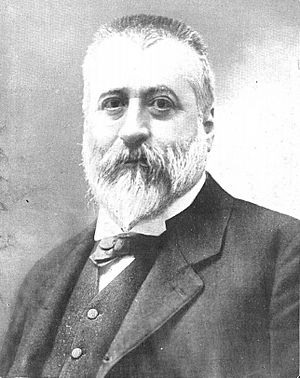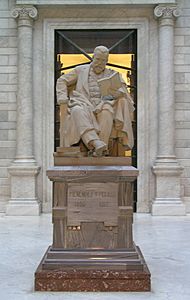Marcelino Menéndez y Pelayo facts for kids
Quick facts for kids
Marcelino Menéndez y Pelayo
|
|
|---|---|

Photograph by Kaulak
|
|
| Born | 3 November 1856 Santander, Spain |
| Died | 12 May 1912 Santander, Spain |
| Nationality | Spanish |
| Occupation | Philologist, literary critic, historian, philosopher, poet, politician |
| Awards | |
| Signature | |
 |
|
| Position held | member of the Senate of Spain, Vocal of the Junta para Ampliación de Estudios e Investigaciones científicas (1907–) |
Marcelino Menéndez y Pelayo (born November 3, 1856 – died May 19, 1912) was a very important Spanish scholar, historian, and literary critic. He was interested in the history of ideas and philology, which is the study of language in historical texts. He also wrote poetry, translated works, and studied philosophy. He was even nominated for the Nobel Prize in Literature five times!
Contents
Biography
Marcelino was born in Santander, Spain. He was a child prodigy, meaning he was extremely talented from a very young age. His brother once said that Marcelino translated a famous Roman poem by Virgil at age twelve without needing a dictionary. He also read a whole book about the History of England at that age.
Early Education and Success
At just 15, he began studying literature at the University of Barcelona. After that, he went to the Complutense University of Madrid. He was so successful in his studies that a special law was passed. This law allowed him to become a professor at the young age of 22.
Just three years later, in 1880, he became a member of the Royal Spanish Academy. This is a very important group that looks after the Spanish language. By then, he was already well-known across Spain for his amazing knowledge.
Key Works and Ideas
One of his first important books was Horacio en España (1877). This book looked at how the Roman poet Horace's works were translated into Spanish.
He became famous for his book Ciencia española (1878). In this work, he argued that Spain had a strong tradition of scientific thought. He also wrote Historia de los heterodoxos españoles (1880–1886). This book explored the history of people in Spain who held different beliefs from the main Catholic Church.
Marcelino's lectures on the famous playwright Calderón in 1881 made him a top literary critic. He continued his work on Spanish literature with his five-volume Historia de las ideas estéticas en España (1883-1891). In this huge work, he explored the history of artistic and literary ideas in Spain.
Later Projects and Legacy
He spent many years publishing the works of the famous Spanish writer Lope de Vega (1890-1902) in 13 volumes. He also created a massive Anthology of Castilian Lyric Poets (1890-1908), which was also 13 volumes long. This collection focused on medieval poetry.
Another big project was Orígenes de la novela ("The origins of the novel"). This work, published in three volumes (1905, 1907, 1910), looked at how novels began. He also published a four-volume Anthology of Hispano-American Poets (1893-1895). This was really a history of poetry from Spanish-speaking America.
Even though some of his ideas about Spanish traditions are now seen differently, his studies of Spanish literature are still very valuable today. He died in Santander and is buried in Santander Cathedral.
Disciples
Marcelino Menéndez y Pelayo had many students who went on to become important scholars themselves. Some of them include:
- Ludwig Pfandl: A German expert on Spain who wrote biographies of many Spanish historical figures.
- Ramón Menéndez Pidal: He is known as the founder of the scientific study of the Spanish language.
- Adolfo Bonilla y San Martín: He edited the complete works of Miguel de Cervantes, who wrote Don Quixote.
Summary of Important Works
Marcelino Menéndez y Pelayo wrote many important books.
- La ciencia española (1876) argued that Spain had a strong scientific history.
- Horacio en España (1877) analyzed how the works of the Roman poet Horace were translated into Spanish.
- His famous work Historia de los heterodoxos españoles (1880–1882) looked at thinkers and writers who were sometimes criticized by traditional Spanish Catholic views. He studied their work from the Middle Ages to the late 1800s.
- Historia de las ideas estéticas en España (1883–1891) was a five-volume work. It explored the history of ideas about art and literature in Spain.
He also took on huge projects like publishing the complete works of Lope de Vega and creating large anthologies of Spanish and Hispano-American poetry. These works helped preserve and study a vast amount of Spanish literature.
Works

- La novela entre los Latinos (Santander, 1875). (His doctoral thesis)
- Estudios críticos sobre escritores montañeses. I. Trueba y Cosío (Santander, 1876).
- Polémicas, indicaciones y proyectos sobre la ciencia española (Madrid, 1876).
- La ciencia española, 2ª edition (Madrid, 1887–1880).
- Horacio en España (Madrid, 1877, 2ª ed. 1885).
- Estudios poéticos (Madrid, 1878).
- Odas, epístolas y tragedias (Madrid, 1906).
- Traductores españoles de la Eneida (Madrid, 1879).
- Traductores de las Églogas y Geórgicas de Virgilio (Madrid, 1879).
- Historia de los heterodoxos españoles (Madrid, 1880–1882).
- Calderón y su teatro (Madrid, 1881).
- Dramas de Guillermo Shakespeare translation (Barcelona, 1881).
- Obras completas de Marco Tulio Cicerón, translation (Madrid, 1881–1884).
- Historia de las ideas estéticas en España (Madrid, 1883–1889).
- Estudios de crítica literaria (Madrid, 1884).
- Obras de Lope de Vega, 1890–1902.
- Antología de poetas líricos castellanos desde la formación del idioma hasta nuestros días, 1890–1908.
- Ensayos de crítica filosófica (Madrid, 1892).
- Antología de poetas hispano-americanos, 1893–1895.
- Historia de la poesía hispano-americana (Madrid, 1911).
- Bibliografía hispano-latina clásica (Madrid, 1902).
- Orígenes de la novela (Madrid, 1905–1915).
- El doctor D. Manuel Milá y Fontanals. Semblanza literaria (Barcelona, 1908).
- Obras Completas, started in 1911.
- "Biblioteca de traductores españoles", in Obras Completas, Madrid
Works in translation
- A History of the Spanish Heterodox, Book One, Translated by Eladia Gomez-Posthill; Saint Austin Press, London, 2009; ISBN: 1-901157-98-9.
See also
 In Spanish: Marcelino Menéndez Pelayo para niños
In Spanish: Marcelino Menéndez Pelayo para niños
- A lo divino

